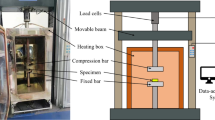Abstract
The micromechanics approach to studying the effect of filler’s mass fraction on the effective elastic properties of the composites is investigated. Poly(ether ether ketone) (PEEK) as matrix and carbon fiber as fillers are used due to excellent nucleation density compared to pure PEEK. The scheme used depends on the single inclusion problem which effectively predicted the mechanical properties considering the orientation, aspect ratio, and mass fraction of the fillers. The main outcome of the study is the moduli variation for 10, 20, and 30% mass fraction reinforced PEEK composites subjected to mechanical and thermal loading simultaneously. It has been observed that above 63 °C, the composite’s elastic properties decrease by 30% mass fraction of CF in PEEK. The maximum failure strength of the composite is 105.32 MPa obtained for a 30% mass fraction of CF in PEEK. In general, the moduli and strength of the composites decrease with the increase in temperature due to the structural change in the polymer.
Access this chapter
Tax calculation will be finalised at checkout
Purchases are for personal use only
Similar content being viewed by others
References
Chen CH, Chang yi H, Cheng ho C (2016) Micromechanics and creep behavior of fiber-reinforced polyether-ether-ketone composites, vol 29, pp 359–371. https://doi.org/10.1177/002199839502900304
Lielens G, Pirotte P, Couniot A, Dupret F, Keunings R (1998) Prediction of thermo-mechanical properties for compression moulded composites. Compos Part A Appl Sci Manuf 29:63–70
Noor AK, Shah RS (1993) Effective thermoelastic and thermal properties of unidirectional fiber-reinforced composites and their sensitivity coefficients. Compos Struct 26:7–23
Kammoun S, Doghri I, Brassart L, Delannay L (2015) Micromechanical modeling of the progressive failure in short glass-fiber reinforced thermoplastics—first pseudo-grain damage model. Compos Part A Appl Sci Manuf 73:166–175
Kundalwal SI (2017) Review on modeling of mechanical and thermal properties of nano- and micro-composites
Doghri I, Brassart L, Adam L, Gérard JS (2011) A second-moment incremental formulation for the mean-field homogenization of elasto-plastic composites. Int J Plast 27:352–371
Dong C (2014) Mechanical and thermo-mechanical properties of carbon nanotube reinforced composites. Int J Smart Nano Mater 5:44–58
Padmanabhan S, Gupta A, Arora G, Pathak H, Burela RG, Bhatnagar AS (2020) Meso–macro-scale computational analysis of boron nitride nanotube-reinforced aluminium and epoxy nanocomposites: a case study on crack propagation. Proc Inst Mech Eng Part L J Mater Des Appl 1–16
Bhatnagar AS, Gupta A, Arora G, Padmanabhan S, Burela RG (2021) Mean-field homogenization coupled low-velocity impact analysis of nano fibre reinforced composites. Mater Today Commun 102089
Katouzian M, Vlase S (2020) Mori–Tanaka formalism-based method used to estimate the viscoelastic parameters of laminated composites. Polym 12:2481
Weng GJ (1990) The theoretical connection between Mori-Tanaka’s theory and the Hashin-Shtrikman-Walpole bounds. Int J Eng Sci 28:1111–1120
Mori T, Tanaka K (1973) Average stress in matrix and average elastic energy of materials with misfitting inclusions. Acta Metall 21:571–574
Benveniste Y (1987) A new approach to the application of Mori-Tanaka’s theory in composite materials. Mech Mater 6:147–157
Peng RD, Zhou HW, Wang HW, Mishnaevsky L (2012) Modeling of nano-reinforced polymer composites: microstructure effect on Young’s modulus. Comput Mater Sci 60:19–31
Hua Y, Gu L (2013) Prediction of the thermomechanical behavior of particle-reinforced metal matrix composites. Compos Part B Eng 45:1464–1470
Arora G, Pathak H (2019) Modeling of transversely isotropic properties of CNT-polymer composites using meso-scale FEM approach. Compos Part B Eng 166:588–597
Arora G, Pathak H (2019) Numerical study on the thermal behavior of polymer nano-composites. J Phys Conf Ser 1240
Mura T (1991) Metal matrix composites: thermomechanical behavior
Zhai J, Cheng S, Zeng T, Wang Z, Jiang L (2017) Thermo-mechanical behavior analysis of 3D braided composites by multiscale finite element method. Compos Struct 176:664–672
Ansari R, Hassanzadeh Aghdam MK (2016) Micromechanics-based viscoelastic analysis of carbon nanotube-reinforced composites subjected to uniaxial and biaxial loading. Compos Part B Eng 90:512–522
Katouzian M, Vlase S (2021) Creep response of carbon-fiber-reinforced composite using homogenization method. Polym 13:867
Maniak I, Melnikov B, Semenov AS, Saikin S (2015) Experimental investigation and finite element simulation of fracture process of polymer composite material with short carbon fibers. Appl Mech Mater 725–726:943–948
Author information
Authors and Affiliations
Corresponding author
Editor information
Editors and Affiliations
Rights and permissions
Copyright information
© 2024 The Author(s), under exclusive license to Springer Nature Singapore Pte Ltd.
About this paper
Cite this paper
Agrawal, B.N., Nain, P.K.S., Bisht, S., Srivastava, A. (2024). Prediction of Effective Elastic Properties of PEEK-CF Composites Subjected to Thermomechanical Loading. In: Tyagi, R.K., Gupta, P., Das, P., Prakash, R. (eds) Advances in Engineering Materials. FLAME 2022. Lecture Notes in Mechanical Engineering. Springer, Singapore. https://doi.org/10.1007/978-981-99-4758-4_19
Download citation
DOI: https://doi.org/10.1007/978-981-99-4758-4_19
Published:
Publisher Name: Springer, Singapore
Print ISBN: 978-981-99-4757-7
Online ISBN: 978-981-99-4758-4
eBook Packages: EngineeringEngineering (R0)




